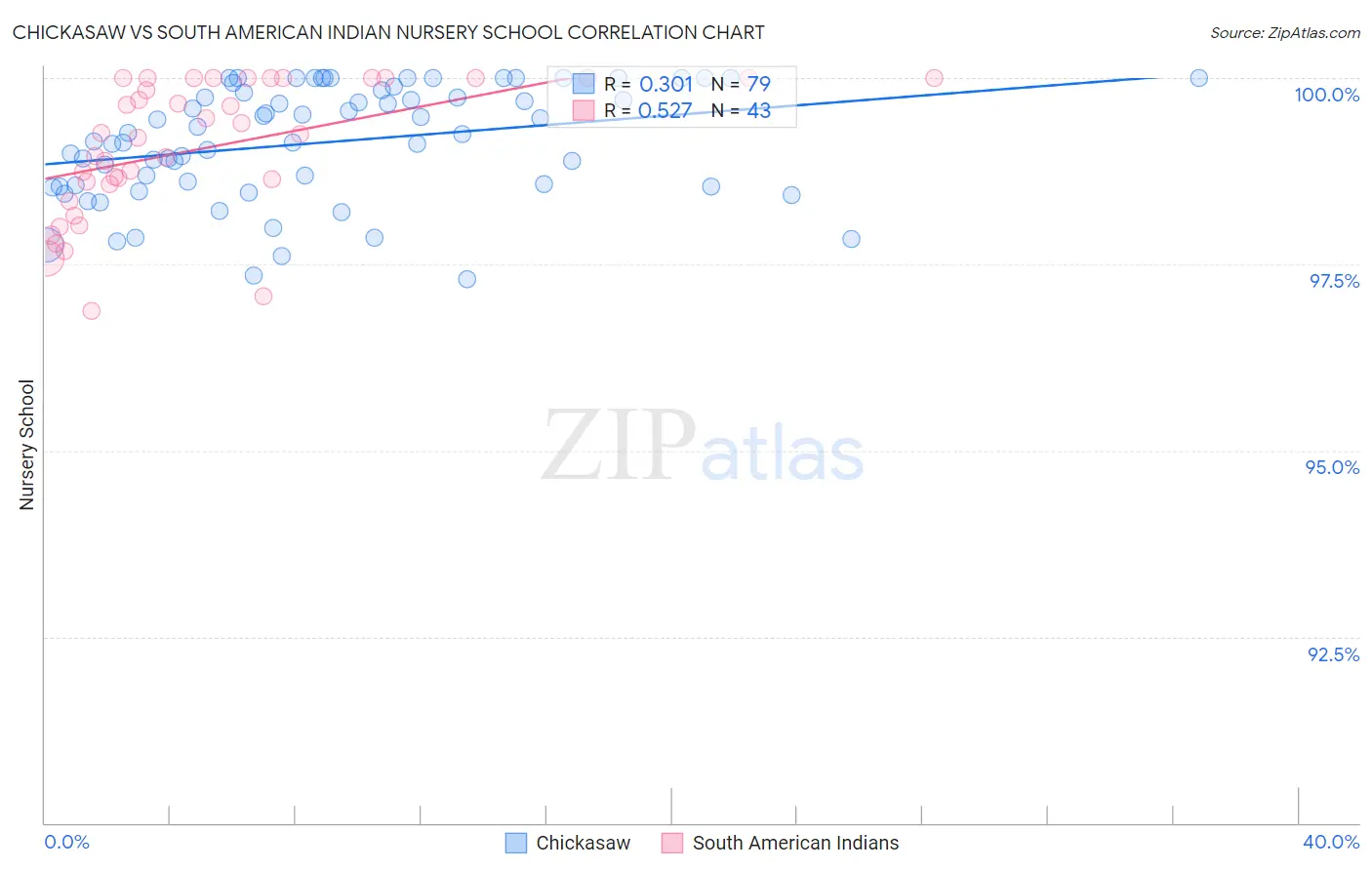Chickasaw vs South American Indian Nursery School
COMPARE
Chickasaw
South American Indian
Nursery School
Nursery School Comparison
Chickasaw
South American Indians
98.4%
NURSERY SCHOOL
99.6/ 100
METRIC RATING
72nd/ 347
METRIC RANK
97.8%
NURSERY SCHOOL
8.0/ 100
METRIC RATING
214th/ 347
METRIC RANK
Chickasaw vs South American Indian Nursery School Correlation Chart
The statistical analysis conducted on geographies consisting of 147,725,081 people shows a mild positive correlation between the proportion of Chickasaw and percentage of population with at least nursery school education in the United States with a correlation coefficient (R) of 0.301 and weighted average of 98.4%. Similarly, the statistical analysis conducted on geographies consisting of 164,573,401 people shows a substantial positive correlation between the proportion of South American Indians and percentage of population with at least nursery school education in the United States with a correlation coefficient (R) of 0.527 and weighted average of 97.8%, a difference of 0.60%.

Nursery School Correlation Summary
| Measurement | Chickasaw | South American Indian |
| Minimum | 97.3% | 96.9% |
| Maximum | 100.0% | 100.0% |
| Range | 2.7% | 3.1% |
| Mean | 99.1% | 99.1% |
| Median | 99.3% | 99.2% |
| Interquartile 25% (IQ1) | 98.6% | 98.6% |
| Interquartile 75% (IQ3) | 99.8% | 100.0% |
| Interquartile Range (IQR) | 1.3% | 1.4% |
| Standard Deviation (Sample) | 0.76% | 0.91% |
| Standard Deviation (Population) | 0.76% | 0.89% |
Similar Demographics by Nursery School
Demographics Similar to Chickasaw by Nursery School
In terms of nursery school, the demographic groups most similar to Chickasaw are Serbian (98.4%, a difference of 0.0%), Canadian (98.4%, a difference of 0.010%), Immigrants from Northern Europe (98.4%, a difference of 0.010%), Russian (98.4%, a difference of 0.010%), and Immigrants from Austria (98.4%, a difference of 0.010%).
| Demographics | Rating | Rank | Nursery School |
| Maltese | 99.7 /100 | #65 | Exceptional 98.4% |
| Canadians | 99.7 /100 | #66 | Exceptional 98.4% |
| Immigrants | Northern Europe | 99.6 /100 | #67 | Exceptional 98.4% |
| Russians | 99.6 /100 | #68 | Exceptional 98.4% |
| Immigrants | Austria | 99.6 /100 | #69 | Exceptional 98.4% |
| Cheyenne | 99.6 /100 | #70 | Exceptional 98.4% |
| Serbians | 99.6 /100 | #71 | Exceptional 98.4% |
| Chickasaw | 99.6 /100 | #72 | Exceptional 98.4% |
| Cajuns | 99.4 /100 | #73 | Exceptional 98.4% |
| Immigrants | Netherlands | 99.4 /100 | #74 | Exceptional 98.4% |
| Cherokee | 99.3 /100 | #75 | Exceptional 98.3% |
| Immigrants | England | 99.3 /100 | #76 | Exceptional 98.3% |
| Immigrants | Lithuania | 99.3 /100 | #77 | Exceptional 98.3% |
| Delaware | 99.3 /100 | #78 | Exceptional 98.3% |
| Immigrants | Belgium | 99.3 /100 | #79 | Exceptional 98.3% |
Demographics Similar to South American Indians by Nursery School
In terms of nursery school, the demographic groups most similar to South American Indians are Moroccan (97.8%, a difference of 0.0%), Immigrants from Bahamas (97.8%, a difference of 0.010%), Bahamian (97.8%, a difference of 0.010%), Uruguayan (97.8%, a difference of 0.010%), and Immigrants from Oceania (97.8%, a difference of 0.020%).
| Demographics | Rating | Rank | Nursery School |
| Africans | 15.4 /100 | #207 | Poor 97.9% |
| Immigrants | Northern Africa | 11.7 /100 | #208 | Poor 97.8% |
| Costa Ricans | 11.3 /100 | #209 | Poor 97.8% |
| Immigrants | Oceania | 10.2 /100 | #210 | Poor 97.8% |
| Laotians | 9.8 /100 | #211 | Tragic 97.8% |
| Immigrants | Bahamas | 8.6 /100 | #212 | Tragic 97.8% |
| Moroccans | 8.3 /100 | #213 | Tragic 97.8% |
| South American Indians | 8.0 /100 | #214 | Tragic 97.8% |
| Bahamians | 7.4 /100 | #215 | Tragic 97.8% |
| Uruguayans | 7.1 /100 | #216 | Tragic 97.8% |
| Samoans | 6.3 /100 | #217 | Tragic 97.8% |
| Immigrants | Panama | 5.3 /100 | #218 | Tragic 97.8% |
| Immigrants | Morocco | 5.1 /100 | #219 | Tragic 97.8% |
| Immigrants | Zaire | 4.4 /100 | #220 | Tragic 97.8% |
| Tongans | 4.3 /100 | #221 | Tragic 97.8% |